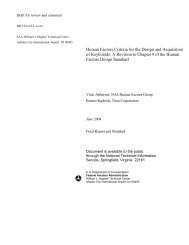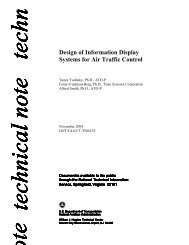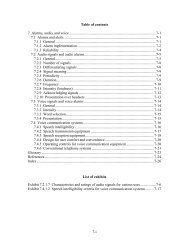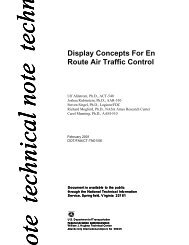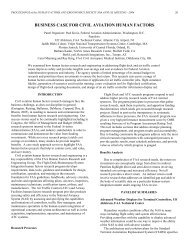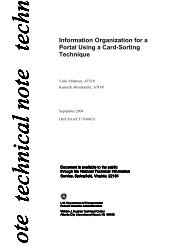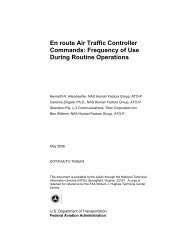Chapter 14. Anthropometry and Biomechanics - FAA
Chapter 14. Anthropometry and Biomechanics - FAA
Chapter 14. Anthropometry and Biomechanics - FAA
Create successful ePaper yourself
Turn your PDF publications into a flip-book with our unique Google optimized e-Paper software.
HFDS 2003 (amended Oct 2009)<strong>Chapter</strong> 14 <strong>Anthropometry</strong> <strong>and</strong> biomechanics• <strong>14.</strong>3.3.1.2 Whole body movement. If large forces that aregreater than 13.6 kg (29.98 lb) or large control displacementsthat are more than 380 mm (<strong>14.</strong>96 in) in a fore-aft direction arerequired, the user shall be given enough space to move his or h erentire body. [Source: MIL-HDBK-759B, 1992]<strong>14.</strong>3.3.2 Joint motionJoint motion capabilities make body movements possible. Jointmovement is measured at the angle formed by the long axes oftwo adjoining body segments or at the angle formed by a bodysegment <strong>and</strong> a vertical or horizontal plane. The total range ofmotion is measured between the two extreme positions of thejoint. The types of movement are defined below <strong>and</strong> areillustrated in Exhibits which follow.Definitions. Abduction is movement away from themidline of the body. Adduction is movement toward themidline. Circumduction is a continuous circularmovement of a limb. Depression is the lowering of abody member from its normal position. Elevation is theraising of a body member from a normal position.Extension is the straightening of a limb or an increase inthe angle between parts of the body. Flexion is theprocess of bending a limb or decreasing the anglebetween parts of the body. Lateral rotation is turningaway from the midline of the body, while medialrotation is turning toward the midline of the body.Pronation is the downward turning of the palm, or lyingface down. Supination is the upward turning of thepalm, or lying face up.• <strong>14.</strong>3.3.2.1 Single joint movements. Designers <strong>and</strong> human factorsspecialists shall use the data in Exhibit <strong>14.</strong>3.3.2.1 for designproblem s involving the movement of a single joint. This Exhibitpresents single joint movement ranges for males <strong>and</strong> females[Source: NASA-STD-3000A, 1989; MIL-HDBK-759B, 1992; DepartmentDefense (MIL-STD-1800A), 1990]. of14-29



